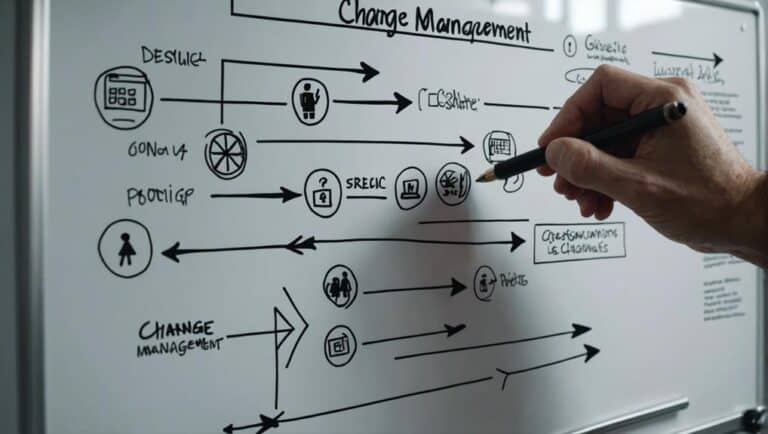To grow and scale your business, you must lead your company through a successful change management strategy. This might include new processes and new roles to evolve the way people think of the organization. But how has change management evolved in recent years?
Change management is changing due to the nature of business and the disruption of the COVID-19 pandemic. Since 2020, many companies have adapted for financial reasons and due to employee safety concerns. Also, employee fatigue has encouraged many leaders to rethink their change management strategy.
In this article, we’ll discuss the evolution of change management, as well as change fatigue, and how to choose the right change management style for your business. We’ll also go over activating the four barriers to change and offer some real-world examples of how it can be implemented.
How Covid-19 Changed Change Management
In the traditional sense, change management focuses on implementing operational changes to an organization’s goals, processes, or technologies. However, in recent years, change management maturity has continued to develop upwards.
The most potent recent disruption is the ongoing COVID-19 pandemic.
Since 2020, organizations have had to continually respond to a large volume of differences in a short period. Some have been highly adaptable and adept at absorbing such developments, driving change management initiatives as business-as-usual for employees.
When the pandemic first struck, organizations implemented decisive changes, including:
- Implementing work from home
- Consolidating operations
- Furloughing employees for their immediate safety and the sustainability of their operations.
As resulting disruptions have continued to surface, organizations preparing for a new work environment have increased organizational complexity.
Due to these unique situations, we have moved from a world where change is managed to a world where people need to be supported, adequately educated, and regularly receive effective action plans.
Change Fatigue Is Growing
Disruption within an organization can be challenging. However, it can offer leaders an opportunity to transform their companies with robust leadership strategies and enable teams to succeed in even the most uncertain business environments.
Unfortunately, when there is a high volume of constant change, it can affect employees’ responses and workflows.
Since the pandemic began, employees have been continuously exerting themselves to contend with new expectations and responsibilities, including:
- Working from home.
- Managing their children’s schedules while addressing work responsibilities from home
- Onboarding new colleagues in virtual sessions.
- Finding working tools for collaboration.
- Implementing new business processes.
All of the above changes and the added pressure of economic uncertainty have led to change fatigue.
Change fatigue encompasses all of the adverse reactions employees experience during the volume of the change process in the organization, including lack of interest, resistance to additional work tasks, frustration, or burnout.
There are several ways to reduce the risk of change fatigue when implementing change management strategies, which we’ll cover in detail below:
Involving Employees in Decisions About Change Strategies
Instead of a top-down approach to change management strategy, try creating a more open and inclusive plan that includes employees in the early stages of the decision-making process.
Adding a layer of inclusivity to your approach will help foster change at all levels of the organization.
It will also equip employees with the fundamentals of the strategy to get them on board.
Additionally, hearing employees’ feedback will help management find ways to carry suggested improvements into final implementation.
Empower Employees To Own Change Implementation Plans
Once you have open dialogues with employees about implementing changes, it’s crucial to engage them in creating operational action plans with their teams.
Empowering your employees will ensure they understand how changes will affect function workflows, reporting structures, and processes.
These action plans should include all groups in the transformation plan’s strategy and define employees’ success metrics, obstacles, and changes to employee networks.
Helping Employees Understand Individual Actions
Successfully achieving change in an organization requires consistent consideration of employees’ mindsets and positive organizational culture.
Unfortunately, change efforts can fail with a lack of understanding of the dynamics of organizational change.
To reduce that frustration — and risk of change fatigue, it’s essential to communicate how modifications will be implemented. In addition, clearly convey what employees need to accomplish and offer specific deadlines that need to be met, including training, ownership of new roles, workflows, etc.
The Right Change Management Style for Your Business
Change is an imperative course of action in today’s dynamic world for companies that look to stay ahead of and beat the market.
Effective change management focuses on project management and practical inclusivity for workers across new processes and business strategies while simultaneously minimizing as many adverse outcomes as possible.
Companies can utilize several types of change management styles, but finding the right approach can significantly impact a successful process. Therefore, it is essential to find the right path that fits your organization’s culture, goals, and business needs.
Developing a more effective change management methodology can focus on one style or a combination of techniques.
Here are a few common areas and types:
- Transformational Change: Involves a large-scale transition affecting the entire organization, including a new vision and strategy and significant changes to functional teams, ways of working, and technology.
- Incremental Change: Involves minor or continuous improvements to an organization made over a more extended period. Gradual change can include slowly implementing new systems, templates, shifts to workflows, pathways, resources, or production systems to optimize how an organization creates values.
- Developmental Change: Focuses on increasing the functionality and proactiveness of the organization without incurring shifts in operation structures or processes. Developmental change can include improving a product’s poor performance, reducing employee burnout, and generally helping the organization.
- People-Centric Change: Focused on influencing the values, roles, and culture to motivate employees.
- Structural Change: Involves changes to organizational leadership or other internal functions and can include planned or unplanned changes.
Common Barriers to Change Management
Unnecessary barriers can create gaps in the overall implementation of a change strategy, resulting in a negative effect on the change implementation. Therefore, when you want to adjust your workplace, it’s imperative to develop a growth mindset embodying a vision that translates into inspiring strategies to implement any modifications.
Though barriers will sometimes appear during change processes, to prevent the obstacles from causing significant issues, it is essential to learn about and adequately understand the barriers to change management and continue to be strategic during initial planning to avoid future problems.
The most common barriers to change management and implementation are often:
Lack of Employee Involvement
Change can bring intense emotions from employees, including fear of the unknown.
So, unless employees are involved in the change process, there may be a lack of involvement, resentment, and even low participation to embrace a new culture.
Disengaged Communication Strategy
An effective communication strategy is pivotal to the success of any change management.
You must involve and inform employees regularly and provide information on:
- Upcoming change expectations
- The purpose of the changes
- How the employees will be affected
- Where resources are available to employees to help them adapt
No Consideration for Current State or Culture
Change can affect the culture of an organization. Therefore, it’s essential to focus on implementing the strategy and regularly analyze its current framework and complexity to understand employees’ needs.
Pulse check assessments can be a valuable tool to gauge employee reactions before introducing or suggesting any change.
Fear of Job Security
Many employees resist organizational change, as they fear a negative impact on their jobs. Fear of this magnitude can include permanent layoffs or changes to current positions regarding role updates and added responsibilities, making processing other change elements difficult.
You can help manage this fear by explaining how your proposed changes will enhance your employees’ development and give them better workflows for their functions.
For example, suppose multiple layoffs are occurring. In that case, you can show how these changes will save money, improve efficiency and merit, and how the changes will enhance productivity so that the remaining employees experience less stress on a day-to-day basis.
It’s important not to ignore these fears but to address employees’ concerns head-on instead to motivate them to embrace the changes ahead.
Failing in the New Environment
Employees might feel increased anxiety over performing and learning new skills and procedures or even reporting structures associated with planned changes.
Giving your employees the information ahead of time and proper training schedules will help them overcome any apprehension.
Presenting the training in stages can also help the employees feel like they are mastering the skills at a manageable pace, making them feel empowered in their new roles.
How to Overcome Barriers to Change Management
To overcome barriers to change management and to successfully implement and execute a successful strategy, ensure you follow the below principles:
Define What You Are Aiming To Accomplish
When planning for a change, it is vital to understand the reasoning and how it will affect all levels of the organization.
In addition, it’s important toalign expectations regarding the scope, timing, and impact of the modification.
Plan For Success
Once you understand how the change will impact stakeholders across the board, it is crucial to design a strategy to help them navigate it.
The plan should include:
- Goals
- Performance indicators
- Possible roadblocks
- Responsibilities of key project stakeholders
- Achievement milestones
Implement The Plan
After the program is developed, it is vital toengage with leaders and associates to execute the changes.
During this phase, change managers must focus on consistent messaging that reminds employees why development is being pursued and empower them to achieve its goals and initiatives.
Communicate Change
Throughout the process, employees should be embedded in the plan, and it is best to ensure teams across the affected functions own their change implementation plans.
Providing resources to help employees understand the actions they need to implement change properly will ensure their actions align with the organization’s change objectives.
Sustain Positive Momentum
In order to succeed, you should continually work with leaders and employees to track adoption and drive lasting change.
Anxiety about differences can be reduced by shifting the focus of change communications from positive and consistent messages to two-way, peer-driven dialogue.
Analyze Results
Once the strategy is complete, it is imperative to analyze how the initiative has improved aspects of the business, hurt other parts of the company, and what areas need to continue to be defined.
By consistently reviewing the progress of the change project, valuable insights that can leverage future change efforts will be gleaned.
Change Management In Action
Most companies want to embed change management to continue building organizational capabilities with strong performance outcomes across the business in a meaningful way.
When Change Thrive Grow (CTG) engages with clients seeking organizational shifts, it defines what a long-term success strategy will look like to achieve sustainable performance.
Below are two examples of successful change management initiatives led by CTG:
CTG Worked With Rolls Royce To Improve Their Efficiencies for Quicker Decision Making
Rolls Royce had an urgent need to control their investments better and improve their ways of working across their portfolio.
As an initial step, CTG stepped in to review their current governance processes and define the immediate business needs of the organization.
Change Management at Rolls Royce
CTG determined that the addition of an external supplier brought onto the team to establish better levels of control would enhance Rolls Royce’s processes, improve management feedback loops, and ensure more equipped decision-making.
With the help and engagement of CTG, a new external supplier was up and running smoothly within three months.
CTG Is Redefining Working With a Leading UK Airport
When a leading UK airport approved CTG, the stated goal was to transform its support services.
Operations, processes, and systems were outdated, restricting employees’ efficiency and scalability for future growth and expansion. More efficient ways of working would help each function reach its potential and deliver a much higher value service.
Change Management at a Leading UK Airport
When CTG was brought on, the client was in the very early stages of mobilizing an ERP-based transformation program.
CTG rapidly developed a transformation strategy by interviewing vital senior stakeholders on existing behavioral and structural challenges. It was made clear that the ERP-based program in its proposed state would not address all of its key challenges.
CTG established a target operating model leg and focused on how each operation needed to change structurally and behaviorally to achieve the target outcomes. Within 12 months, changes to the operating model were implemented ahead of the release of the ERP solution, accelerating the target outcomes.
Although these are just a few examples of change management, each model encompasses the many benefits organizations can receive from change management strategies, including:
- Creating solid values and a greater return on investment
- Responding to challenges more efficiently
- Supporting employees’ development and understanding of organizational initiatives
- Improving collaboration across the business
- Increasing productivity, morale, and culture
- Reducing stress and anxiety amongst employees
Conclusion
Overall, change takes place in your organization every day with new initiatives to increase performance, sales, and competitive advantages. Successful transformation requires a multi-level approach and the buy-in of the workforce to commit, own and support change across all levels.
Although an open style approach can take more time in the planning phase, in the end, having your employees involved throughout the change process will allow for faster implementation and increased employee performance during and after the change.
Sources
- Harvard Business Review: The Hard Side of Change Management
- CIO: What is change management? A guide to organizational transformation
- SHRM: Managing Organizational Change
- Forbes: Change Is Changing: Coping With The Death Of Traditional Change Management
- McKinsey & Company: Changing change management
- Fast Company: The 4 barriers to change and how to overcome them
- Harvard Business School Online: 5 Critical Steps in the Change Management Process
- https://changethrivegrow.com/





